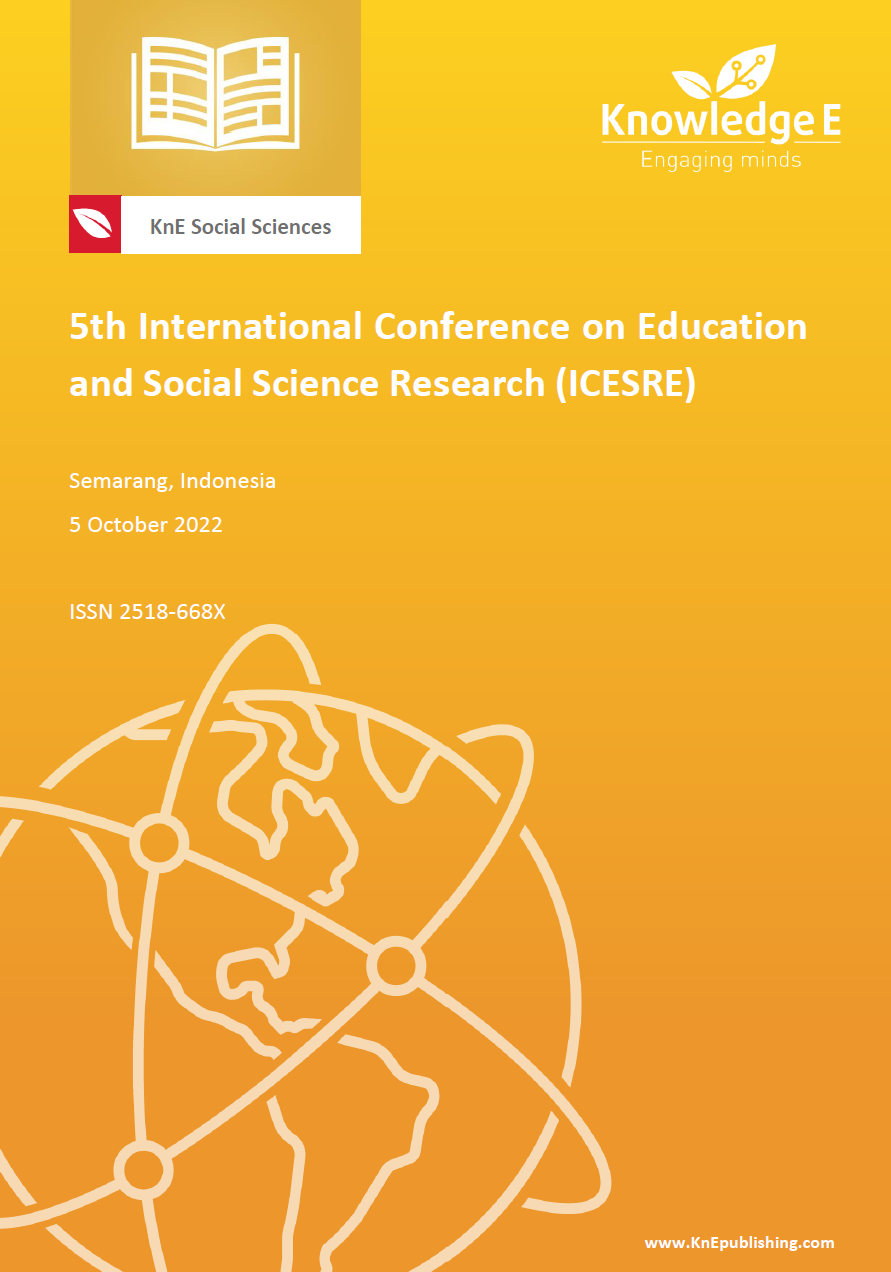Developing a Test of Mathematical Literacy based on STEM-PjBL using ADDIE Model
DOI:
https://doi.org/10.18502/kss.v7i19.12458Abstract
Mathematical literacy is one of the eminent skills in the learning process in the 21st century. However, the mathematical skills of Junior High School students in Indonesia need some improvement. This study aims to develop a test of mathematical literacy based on the integration of Science, Technology, Engineering, and Mathematics (STEM) and Project-based Learning (PjBL). The study involved research and development using the Analysis, Design, Development, Implementation and Evaluation model (ADDIE). The results showed that the developed mathematical literacy test based on STEM-PjBL is valid and practical to be implemented by the expert validator. Moreover, the construct validity through implementation in the classroom obtained the result that the instrument is valid and reliable. This instrument is expected to be disseminated to the wider population to accustom the students to the problem embedded in project-based learning and STEM activities.
Keywords: Mathematical Literacy; Instrument Test; STEM-PjBL; ADDIE Model
References
Ojose B. Mathematics literacy: Are we able to put the mathematics we learn into everyday use. Journal of Mathematics Education. 2011;4:89–100.
Organisation for Economic Co-operation and Development. PISA 2015 assessment and analitycal framework: Mathematics, reading, science. OECD Publishing; 2017.
Stacey K, Turner R. Assessing mathematical literacy. Stacey K, Turner R, editors. Germany: Springer International Publishing; 2015. The evolution and key concepts of the PISA mathematics frameworks. p. 5–33.
Steen LA, Turner R, Burkhardt H. Modelling and applications in mathematics education: The 14th ICMI Study. Blum W, Galbraith PL, Henn H-W, Niss M, editors. Germany: Springer; 2007. Developing mathematical literacy. p. 285–294.
Kusumawardani DR, Wardono, Kartono. Pentingnya penalaran matematika dalam meningkatkan kemampuan literasi matematika. Prisma, Prosiding Seminar Nasional Matematika. 2018:588–595.
Kuswidi I. Brain-based learning untuk meningkatkan literasi matematis siswa. AlJabar: Jurnal Pendidikan Matematika. 2017;6:133–144.
Anugraheni I. Analisis kemampuan berpikir kritis mahasiswa dalam menyelesaikan permasalahan bilangan bulat berbasis media realistik. Jurnal Pendidikan dan Kembudayaan. 2015:276–283.
Charmila N, Zulkardi, Darmowijoyo. Pengembangan soal matematika model PISA menggunakan konteks jambi. Jurnal Penelitian dan Evaluasi Pendidikan 2016;20:198–207.
Tai WC, Lin SW. Relationship between problem solving style and mathematical literacy. Educational Research and Reviews. 2015;10:1480–1486.
Bishop AJ, Clements MK, Clements K, Keitel C, Kilpatrick J, Laborde C. International handbook of mathematics education (Vol. 4). Netherland: Kluwer Academic Publishers; 1996.
Matters G. Educational assessment in the 21st century. Wyatt-Smith C, Cumming JJ, editors. Germany: Springer; 2009. A problematic leap in the use of test data: From performance to inference. p. 209–225.
Kuger S, Klieme E, Jude N, Kaplan D. Assessing contexts of learning: An international perspective. Germany: Springer; 2016.
Friyatmi, Mardapi D, Haryanto, Rahmi E. The development of computerized economics item banking for classroom and school-based assessment. European Journal of Educational Research. 2020;9:293–303.
CoPo ARI. Students’ initial knowledge state and test design: Towards a valid and reliable test instrument. Journal of College Teaching & Learning. 2015;12:189–194.
Triyatma, Ratmawati Y, Ridwan A, Budiningsih A, Suryani E, Nurliatani A. Keterampilan Abad 21 dan STEAM (Science, Technology, Engineering, Art and Mathematics) Project dalam Pembelajaran Kimia. Jakarta. 2017.
Pramasdyahsari AS, Farida NS, Irkham UA, Lilik A. Mathematics joyful learning STEAM based for lower class. Semarang: UPGRIS Press; 2021.
Nursyahidah FN, Pramasdyahsari AS, Irkham UA, Lilik A. Modul mathematics joyful learning STEAM based for primary upper class. Semarang: UPGRIS Press; 2021.
Irkham UA, Nursyahidah FN, Pramasdyahsari AS, Lilik A. Modul pelatihan joyful mathematics learning junior high school. Semarang: UPGRIS Press; 2021.
Guo S, Yang Y. Project-based learning: An effective approach to link teacher professional development and students learning. Journal of Educational Technology Development and Exchange. 2012;5:41–56.
Lutfi, Ismail, Andi Asmawati Azis. Effect of project-based learning integrated stem against science literacy, creativity and learning outcomes on environmental pollution subject. Prosiding Seminar Nasional Biologi dan Pembelajarannya. 2018:189–194.
Dick W, Carey L. The systematic design of instruction. 4th ed. New York: Harper Collins College Publishers; 1996.
Azwar S. Validitas dan reliabilitas. Pustaka Pelajar; 2007
Anderson LW. Classroom assessment: Enhancing the quality of teacher decision making. Lawrence Erlbaum Associates; 2003.
American Educational Research Association. Standards for educational and psychological testing. AERA; 2014.
Allen MJ, Yen WM. Introduction to measurement theory. California, USA: Brooks/Cole Publishing Company; 1979.
Crocker L, Algina J. Introduction to classical and modern test theory. New York: Holt Rinehard and Winston Inc.; 1986.
Nunnally JC, Bernstein I. Psychometric testing. 3rd ed. New York: McGraw-Hill; 1978.
Retnawati H. Validitas reliabilitas dan karakteristik butir (Validity, reliability, and item characteristics). Bangladesh: Parama Publishing; 2015.
Stanley JC. Educational measurement. 2nd ed. Thorndike RL, editor. American Council and Education; 1971. Reliability.

